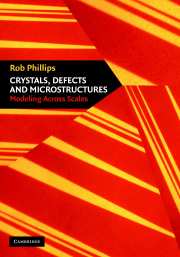Book contents
- Frontmatter
- Contents
- Preface
- Acknowledgements
- Notes on Units, Scales and Conventions
- Part One Thinking About the Material World
- 1 Idealizing Material Response
- 2 Continuum Mechanics Revisited
- 3 Quantum and Statistical Mechanics Revisited
- Part two Energetics of Crystalline Solids
- Part three Geometric Structures in Solids: Defects and Microstructures
- Part four Facing the Multiscale Challenge of Real Material Behavior
- References
- Index
3 - Quantum and Statistical Mechanics Revisited
Published online by Cambridge University Press: 29 October 2009
- Frontmatter
- Contents
- Preface
- Acknowledgements
- Notes on Units, Scales and Conventions
- Part One Thinking About the Material World
- 1 Idealizing Material Response
- 2 Continuum Mechanics Revisited
- 3 Quantum and Statistical Mechanics Revisited
- Part two Energetics of Crystalline Solids
- Part three Geometric Structures in Solids: Defects and Microstructures
- Part four Facing the Multiscale Challenge of Real Material Behavior
- References
- Index
Summary
Background
In the previous chapter we examined the central tenets of continuum mechanics with an eye to how these ideas can be tailored to the modeling of the mechanical properties of materials. During our consideration of continuum mechanics, we found that one of the key features of any continuum theory is its reliance on some phenomenological constitutive model which is the vehicle whereby mechanistic and material specificity enter that theory. As was said before, the equations of continuum dynamics are by themselves a continuous representation of the balance of linear momentum and make no reference to the particulars of the material in question. It is the role of the constitutive model to inform the equations of continuum dynamics whether we are talking about the plastic deformation of metals or the washing of waves across a beach. A key realization rooted in the microscopic perspective is the idea that the constitutive response, used in the continuum settings described in the previous chapter, reflects a collective response on the part of the microscopic degrees of freedom. It is the business of quantum and statistical mechanics to calculate the average behavior that leads to this collective response. In addition to our interest in effective macroscopic behavior, one of our primary aims is to produce plausible microscopic insights into the mechanisms responsible for observed macroscopic behavior. For example, is there a microscopic explanation for the difference in the Young's modulus of lead and silicon? Or, under what conditions might one expect to see creep mediated by grain boundary diffusion as opposed to bulkdif fusion? Or, how does the yield strength depend upon the concentration of some alloying element?
- Type
- Chapter
- Information
- Crystals, Defects and MicrostructuresModeling Across Scales, pp. 81 - 146Publisher: Cambridge University PressPrint publication year: 2001

